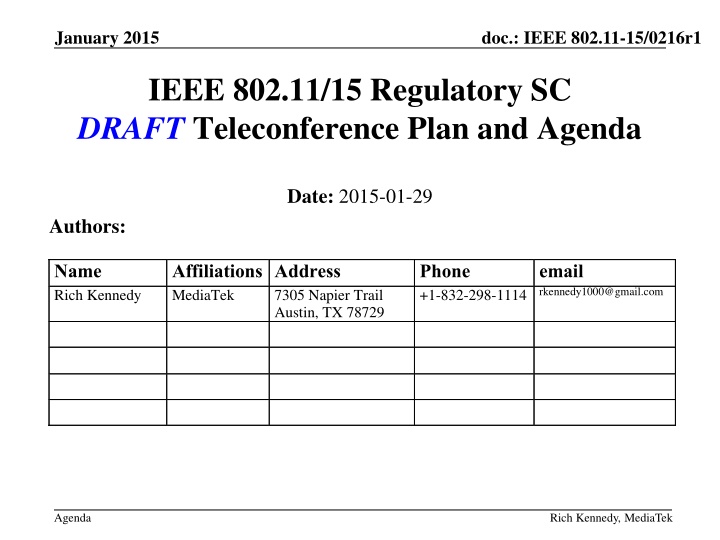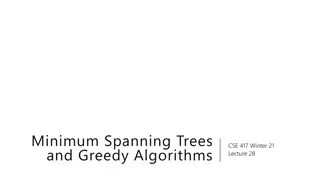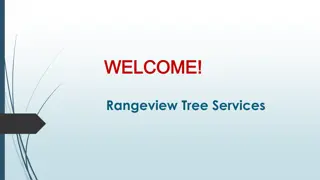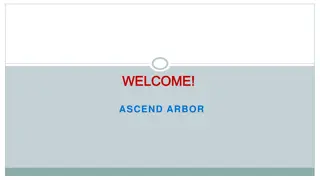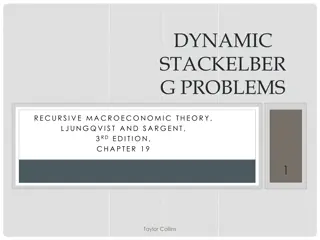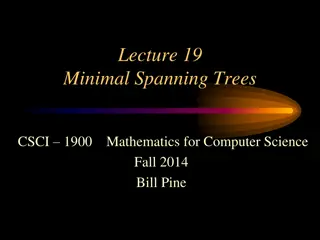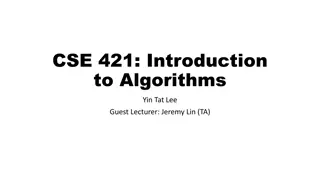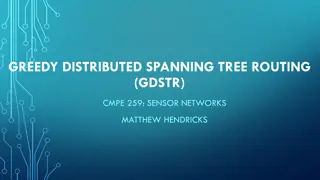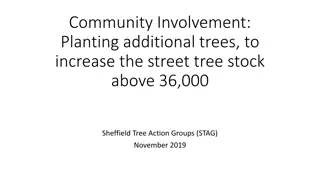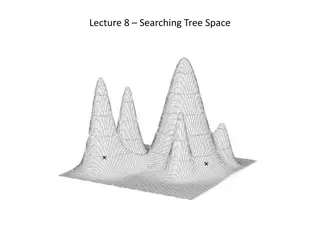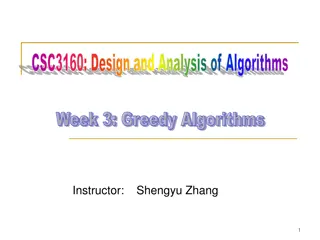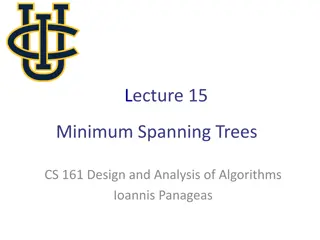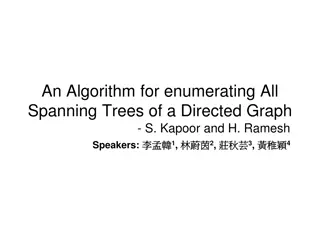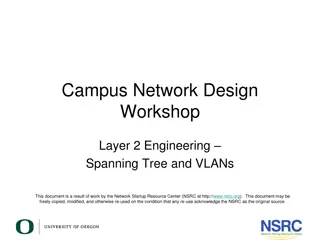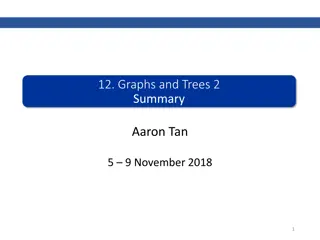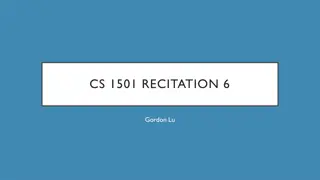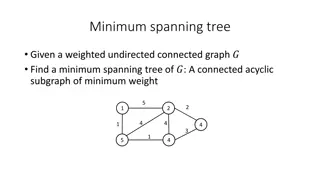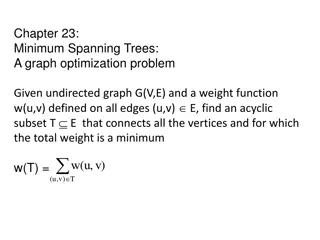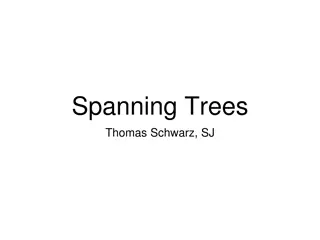The Stackelberg Minimum Spanning Tree Game Overview
This overview covers the Stackelberg Minimum Spanning Tree Game, discussing its concept, complexity, inapproximability, and key results related to polynomial-time approximation algorithms. Explore the nuances of APX-hard problems, polynomial-time approximation schemes, and the relationship between P, NP, and PTAS in optimization.
Download Presentation

Please find below an Image/Link to download the presentation.
The content on the website is provided AS IS for your information and personal use only. It may not be sold, licensed, or shared on other websites without obtaining consent from the author.If you encounter any issues during the download, it is possible that the publisher has removed the file from their server.
You are allowed to download the files provided on this website for personal or commercial use, subject to the condition that they are used lawfully. All files are the property of their respective owners.
The content on the website is provided AS IS for your information and personal use only. It may not be sold, licensed, or shared on other websites without obtaining consent from the author.
E N D
Presentation Transcript
January 2015 doc.: IEEE 802.11-15/0216r1 IEEE 802.11/15 Regulatory SC DRAFT Teleconference Plan and Agenda Date: 2015-01-29 Authors: Name Rich Kennedy Affiliations Address MediaTek Phone +1-832-298-1114 rkennedy1000@gmail.com email 7305 Napier Trail Austin, TX 78729 Agenda Rich Kennedy, MediaTek
January 2015 doc.: IEEE 802.11-15/0216r1 Abstract This presentation is the plan for the January 29, 2015 IEEE 802.11/15 Regulatory Standing Committee teleconference. Agenda Rich Kennedy, MediaTek
January 2015 doc.: IEEE 802.11-15/0216r1 Agenda Assign a recording secretary Administrative items Open items NPRM FCC 14-144 TVWS and the 600 MHz band NOI FCC 14-154 Frequencies above 24 GHz EN 301 893 v1.8.1 LAA in 5 GHz DSRC Coexistence Tiger Team status Other regulatory updates Inputs for Globalstar meeting at the FCC AOB Agenda Rich Kennedy, MediaTek
January 2015 doc.: IEEE 802.11-15/0216r1 Administrative Items Required notices Affiliation FAQ - http://standards.ieee.org/faqs/affiliationFAQ.html Anti-Trust FAQ -http://standards.ieee.org/resources/antitrust-guidelines.pdf Ethics - http://www.ieee.org/portal/cms_docs/about/CoE_poster.pdf IEEE 802.11 Working Group Policies and Procedures - https://mentor.ieee.org/802.11/public-file/07/11-07-0360-04-0000-802-11-policies- and-procedures.doc Chair and Secretary Chair is Rich Kennedy (MediaTek) Peter will act as Recording Secretary Please send an email to the addresses below to have your attendance recorded rkennedy1000@gmail.com pecclesi@cisco.com Agenda Rich Kennedy, MediaTek
January 2015 doc.: IEEE 802.11-15/0216r1 SC Operating Rules Anybody can vote, present, and make motions Participation in SC during 802.11/15 WG Plenary or Interim counts towards 802.11 or 802.15 voting rights All motions must pass by a 75% majority Agenda Rich Kennedy, MediaTek
January 2015 doc.: IEEE 802.11-15/0216r1 Other Guidelines for IEEE WG Meetings All IEEE-SA standards meetings shall be conducted in compliance with all applicable laws, including antitrust and competition laws. Don t discuss the interpretation, validity, or essentiality of patents/patent claims. Don t discuss specific license rates, terms, or conditions. Relative costs, including licensing costs of essential patent claims, of different technical approaches may be discussed in standards development meetings. Technical considerations remain primary focus Don t discuss or engage in the fixing of product prices, allocation of customers, or division of sales markets. Don t discuss the status or substance of ongoing or threatened litigation. Don t be silent if inappropriate topics are discussed do formally object. --------------------------------------------------------------- If you have questions, contact the IEEE-SA Standards Board Patent Committee Administrator at patcom@ieee.org or visit http://standards.ieee.org/about/sasb/patcom/index.html See IEEE-SA Standards Board Operations Manual, clause 5.3.10 and Promoting Competition and Innovation: What You Need to Know about the IEEE Standards Association's Antitrust and Competition Policy for more details. This slide set is available at https://development.standards.ieee.org/myproject/Public/mytools/mob/slideset.ppt Agenda Rich Kennedy, MediaTek
January 2015 doc.: IEEE 802.11-15/0216r1 IEEE802.11af NPRM FCC 14-144 Changes to TVWS device and 600 MHz band rules Low-power fixed mode enabled Changes to power limits in adjacent channels, channel 37 New operating modes on the boundary of two unused adjacent channels Many questions aimed at improving WS spectrum availability Personal/portable exclusion below channel 21 lifted Low VHF channels now usable Duplex gap options based on amount of recovered TV band spectrum The Regulatory SC decided not to take on this large proceeding Wi-Fi Alliance did file Comments and will file Reply Comments Comment period closes February 5, 2015 Reply Comment closes February 26, 2015 Agenda Rich Kennedy, MediaTek
January 2015 doc.: IEEE 802.11-15/0216r1 IEEE802.11ad/NG60 NOI FCC 14-154 Frequencies above 24 GHz Use of Spectrum Bands Above 24 GHz For Mobile Radio Services Amendment of the Commission s Rules Regarding the 37.0-38.6 GHz and 38.6-40.0 GHz Band Implementation of Section 309(j) of the Communications Act Competitive Bidding, 37.0-38.6 GHz and 38.6-40.0 GHz Bands Petition for Rulemaking of the Fixed Wireless Communications Coalition to Create Service Rules for the 42-43.5 GHz Band Includes discussion of expanding the 57-64 GHz unlicensed band by another 7 GHz (to 71 GHz) Use of the 70/80 GHz bands Comment period closed on January 15, 2015 Reply Comment closes February17, 2015 Agenda Rich Kennedy, MediaTek
January 2015 doc.: IEEE 802.11-15/0216r1 IEEE802.11ac/ax ETSI EN 301 893 v1.8.1 Meeting was in Las Palmas, Gran Canaria December 16-19 LBT for load-based devices wording is open to interpretation Requirements can be met while preventing shared access Wording needs to be clarified to ensure fair spectrum sharing Output version will go into effect January 1, 2015 Corrected LBT better model for coexistence studies Agenda Rich Kennedy, MediaTek
January 2015 doc.: IEEE 802.11-15/0216r1 IEEE802.11ac/ax LAA in 5 GHz Besides the 3GPP liaison, what should IEEE 802 do? 3GPP planning simulations based on EN 301 893 v1.7.1 1.7.1 not approved 1.7.2 has sharing issues ETSI BRAN working on LBT wording for 1.8.1 Agenda Rich Kennedy, MediaTek
January 2015 doc.: IEEE 802.11-15/0216r1 IEEE802.11ac/ax DSRC Coexistence Tiger Team Meeting for over one year Two proposals Proposal #1 has potential and some support from the auto industry Proposal #2 best for 802.11ac, but has no support from automakers, DOT Regulators have stated they will not make changes to DSRC channelization We will close this effort shortly Unless a compromise is proposed before November, the SC will vote on continuation of the Tiger Team beyond January 2015 in San Antonio Tiger Team will straw poll options to guide SC voting Many from DSRC community do not have IEEE802.11 voting rights Purpose of the TT was to include them regardless of voting rights What should be the deliverables if no compromise is reached? We will inform the FCC of the results when the process completes Agenda Rich Kennedy, MediaTek
January 2015 doc.: IEEE 802.11-15/0216r1 Other Open Items Still waiting for FCC decision on Globalstar TLPS Early indications are FCC will allow FCC is testing interference claims FCC has invited WFA (and Bluetooth SIG, NCTA and WISPA) and Globalstar to a meeting in February to finalize this proceeding Agenda Rich Kennedy, MediaTek
January 2015 doc.: IEEE 802.11-15/0216r1 Notes for FCC Presentation - Comments Any Wi-Fi installer can tell you why 22 MHz of separation between OFDM Wi-Fi APs is a bad idea 15 years of experience trumps any testing Globalstar may have done: all things being equal, for OFDM, 25 MHz of separation has proven to be a workable minimum; we cannot test ch14 [show how FCC network configuration uses no intermediate channels] 22 MHz separation can work with the DSSS technology these channels designations were designed for, but since OFDM became the dominant Wi-Fi technology in the 2.4 GHz band (802.11g/n), this no longer is viable, which is why, lacking proper guidance, off-channel (1/6/11) Wi-Fi is currently the largest source of interference for Wi-Fi Most residential and enterprise Wi-Fi APs do not operate at maximum TX power (get some numbers), and Globalstar states that they intend to (GS quote here), exacerbating the interference potential We understand that FCC Part 15 provides no legal protection for Wi-Fi, but for the public interest, i.e. the 100M+ users on-ramp to the Internet *, allowing TLPS to operate on ch14 would serve only to diminish the valuable resource that the Commission helped create We have no technical concerns with TLPS operation in the Globalstar licensed band, but the claims for its value seem overly ambitious considering it would be only a single channel to be shared by the large number of services that would migrate to it to aid the decongestion of existing 2.4 GHz band (use quotes from GS) Agenda Rich Kennedy, MediaTek
January 2015 doc.: IEEE 802.11-15/0216r1 Other Regulatory Updates Agenda Rich Kennedy, MediaTek
